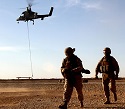Lockheed Martin’s OPTIMUS system tested by Office of Naval Research

cargo helicopter
As autonomous technologies continue to develop and grow within the U.S. Marine Corps and the U.S. Navy, Lockheed Martin and the Office of Naval Research (ONR) successfully demonstrated the Lockheed Martin OPTIMUS mission system’s ability to accomplish an autonomous approach and landing in an unprepared environment.
The system enhances the onboard intelligence of the vehicle and provides an advanced mission planning capability that can be applied to current and future helicopters and rotary wing aircraft.
The Autonomous Aerial Cargo/Utility System (AACUS) demonstration tested Lockheed Martin OPTIMUS technology aboard a K-MAX unmanned helicopter, which served as a test bed for the system. During the demonstration, an active duty Marine interfaced with the mission system’s handheld flight control device to complete a resupply mission. The system successfully planned, routed and executed the mission without requiring user input.
“The Lockheed Martin OPTIMUS suite of systems and sensors use an open architecture positioned for Future Airborne Capability Environment (FACE) compliance, which applies and adapts both legacy and future mission systems to airborne assets,” said Roger Il Grande, director of Airborne Systems Programs for Lockheed Martin’s Mission Systems and Training business. “As we continue to operate on a fast-moving battlefield, additional mission modules can be added or removed without costly overhauls to the system, providing an advanced, flexible capability for the U.S. Marine Corps and the U.S. Navy.”
Lockheed Martin OPTIMUS primes aircraft for operations in austere environments or terrains, and allows users to execute missions day and night, in all weather conditions. Additionally, the system adds a multi-layer world model and active sensor control to enhance onboard perception and understanding for missions in which operators have limited or no knowledge of the location.
In addition to military applications, Lockheed Martin OPTIMUS can be used on commercial platforms for forestry and construction, pipelining, and firefighting missions because it can reach areas without improved roads, work around-the-clock, and provide valuable situational awareness to its operators.







